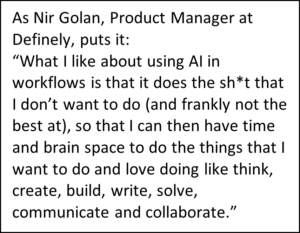
The Reality Check: AI Isn’t Magic, and That’s a Good Thing
Legal AI promises transformation. But if you ask most legal professionals, the day-to-day reality still looks remarkably familiar – crowded inboxes, slow document review, clunky tools, and compressed time for deep thinking.
It turns out most AI tools haven’t been built to fit how legal professionals actually work, which makes them hard to trust, hard to use, and even harder to adopt.
According to Success Tactics for Legal Teams Using AI in 2025, only 34% of legal teams report measurable benefits from AI. In the UK, satisfaction with current tools drops to just 22%. Even in the U.S., only about half of respondents say their AI tools are delivering.
That tells us that most tools are missing the mark. Not because AI is flawed, but because too many products promise transformation without delivering basic utility and a specific problem to solve – the kind that actually matters in the day-to-day practice of law.
In fact, lawyers are eager to explore real solutions. A recent LegalTech adoption report shows 74% of legal professionals agree AI has the potential to transform their work, but only 27% say their current tools are delivering on that promise.
The gap isn’t only skepticism — it’s unmet expectations.
The Toil Problem: Why Lawyers Still Burn Time on Work AI Could Handle

Here’s the thing: legal professionals aren’t looking for AI, they’re looking for relief from the grind of repetitive tasks, and what’s more repetitive than time spent reformatting, redlining, comparing versions, and chasing consistency.
So many tools have been built around abstract ideas of “innovation” for its own sake that lawyers are right to feel skeptical of the value of AI in their day-to-day. What’s needed are solutions that actually reduce the burden, tools that fit into the existing workflow and make drafting, reviewing, and finalizing documents easier—not more complicated.
When AI is embedded where lawyers already work, without requiring them to change behavior or learn something new, it stops feeling like tech. It just feels helpful.
Legal Work Lives in Microsoft Word: Let’s Solve for That
Tools that disrupt well-established workflows or fail to interoperate with existing systems face significant resistance.
Lawyers spend countless hours inside Microsoft Word and much of that time is lost to the same tedious, manual tasks: fixing cross-references, checking clause consistency, formatting footnotes, and tracking defined terms across sprawling documents. These aren’t high-value legal activities – they’re workflow bottlenecks.
That’s why the most effective AI tools in legal don’t try to reinvent the wheel. They streamline the grunt work within Word itself, helping lawyers move faster, make fewer errors, and focus on the substantive work that actually matters.
What Success Actually Looks Like: Time
The real promise of legal AI isn’t disruption — it’s time. Time to think, write, collaborate, and actually practice law. Imagine cutting the turnaround time for a 120-page legal document from days to just hours — without changing platforms, retraining staff, or rewriting your workflow. Picture never having to worry about formatting or cross-references again — because it’s just handled, automatically.
Think about working in Microsoft Word, exactly as you always have, but with intelligent tools quietly helping you move faster, catch more, and stress less.
These aren’t hypotheticals. They’re the kinds of everyday wins legal professionals shared in Success Tactics. When AI is embedded into familiar workflows — not bolted on — it doesn’t feel like a leap. It just works.
Your Next Move: Start With the Right Questions
If you’re evaluating legal AI tools, start with the fundamentals. What’s the actual problem this tool is solving? Will it make your team faster, more accurate, or just more frustrated? Does it integrate into how your lawyers already work – or demand they change?
The Success Tactics guide includes a practical checklist to help you cut through the noise:
- What specific workflow pain points does it address?
- Does it integrate with tools you already use — like Microsoft Word?
- Can you define and measure success?
- Is it built with legal users in mind?
- How much change management will it take?
- Will it save time, or create new tasks?
The promise of legal AI isn’t about chasing innovation. It’s about clearing the path for real work to happen. That means cutting the clutter and automating the drudgery – i.e., the shi*t work – and giving legal professionals their time back.
When AI takes care of that, the real value (not magic) happens – lawyers get to focus on the work that actually requires them: thinking, advising, writing – and winning.
Download Success Tactics: The Reality of AI and LegalTech Automation to learn more!
